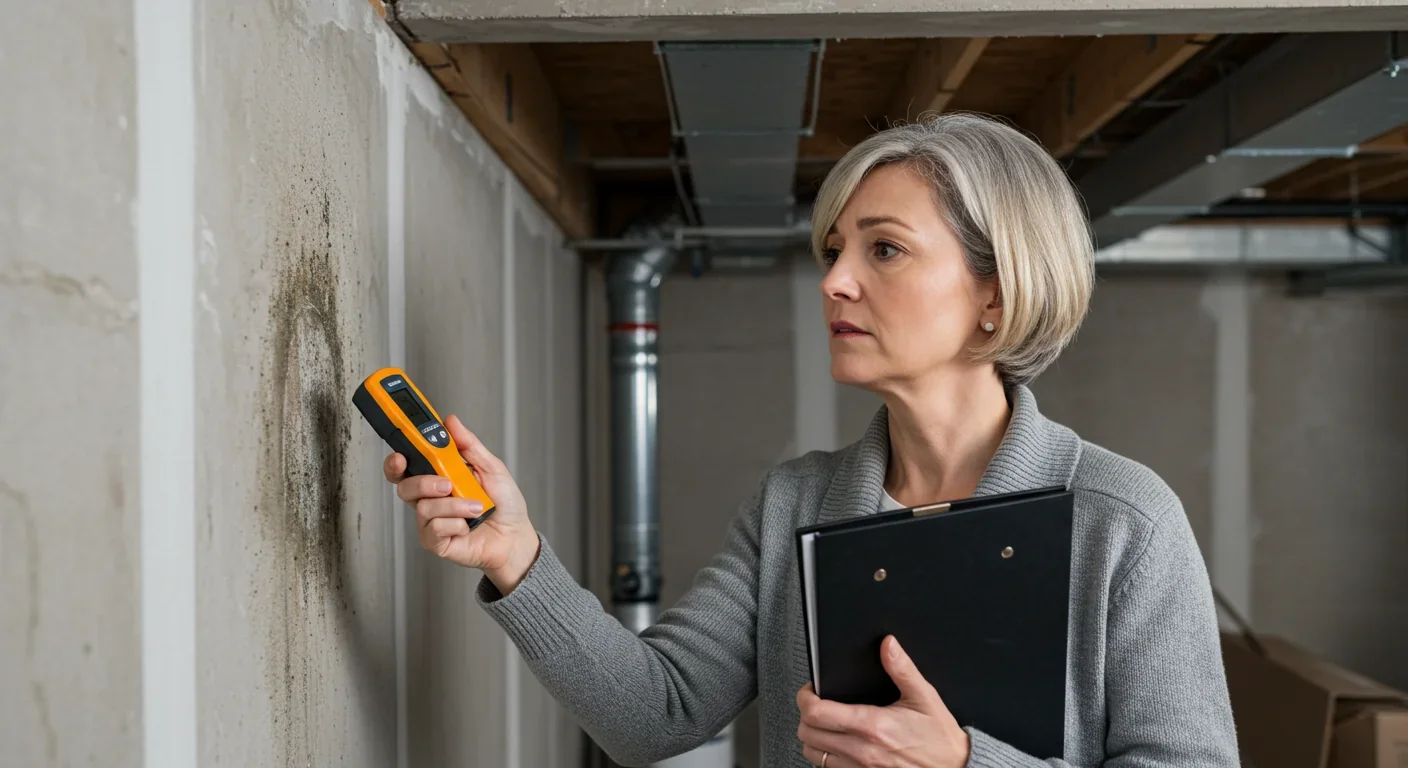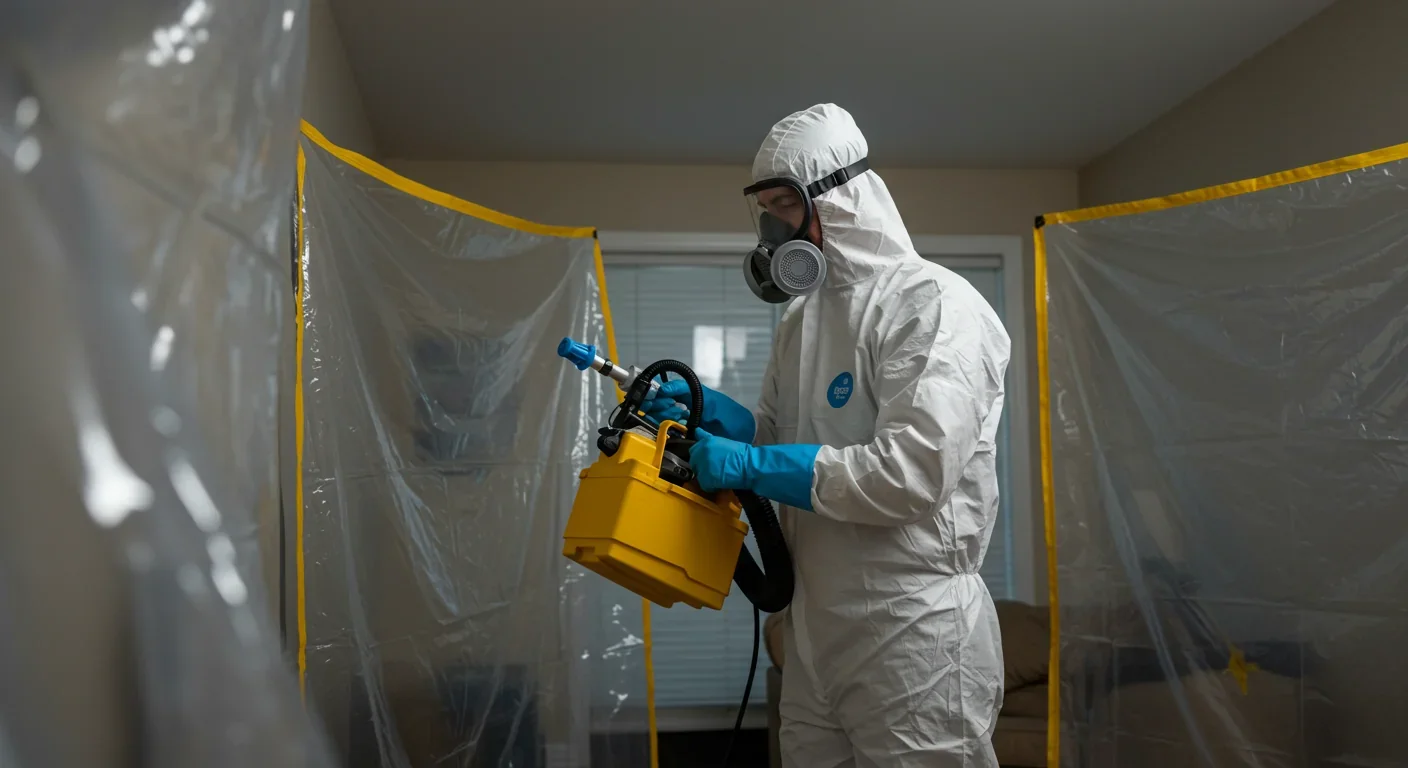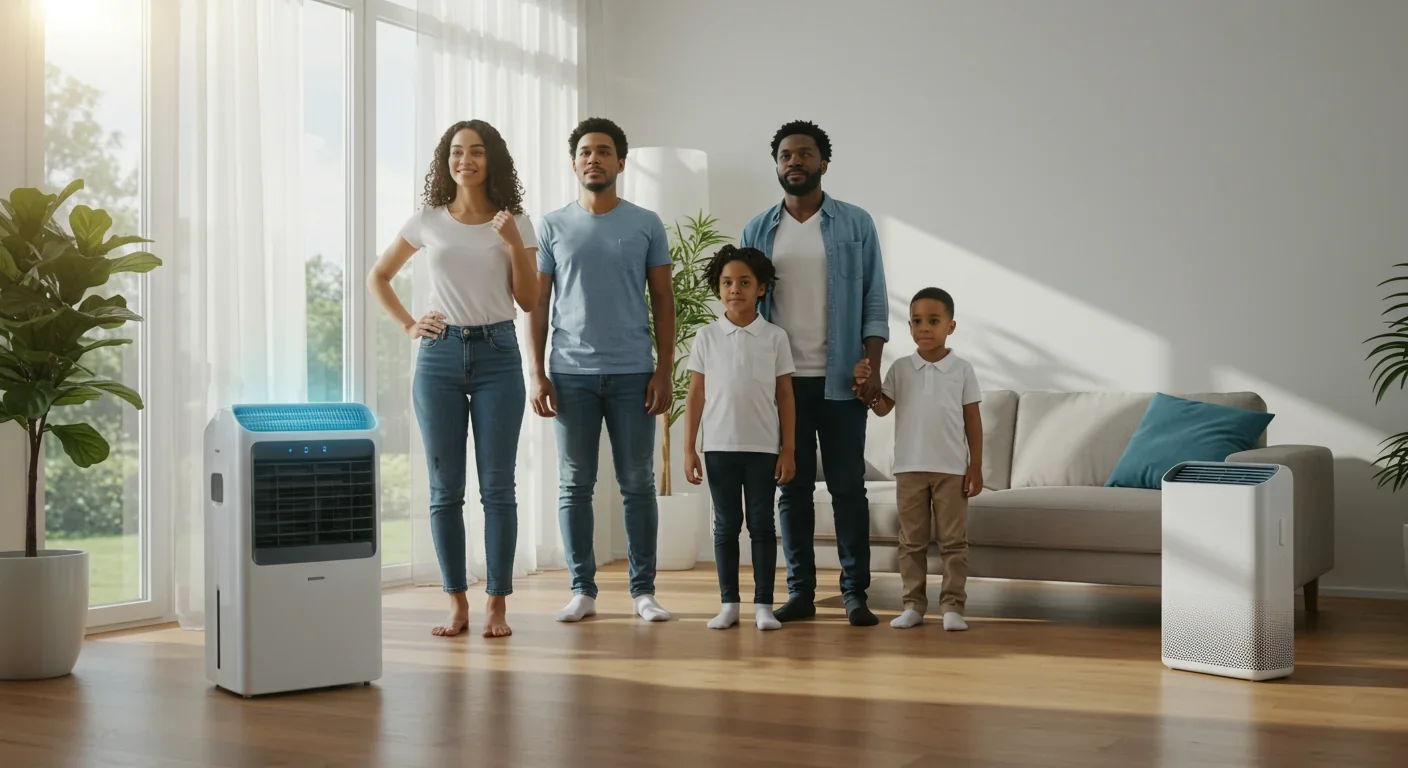Epigenetic Clocks Predict Disease 30 Years Early

TL;DR: Hidden mold in homes releases invisible mycotoxins—toxic chemicals that persist long after mold removal, triggering chronic fatigue, brain fog, immune dysfunction, and neurological damage. Up to 50% of buildings harbor mold, yet most mycotoxin exposure goes undetected. Cutting-edge airborne testing, professional remediation, and medical detox protocols can reveal and reverse this silent epidemic, empowering individuals to reclaim their health.

Imagine living on a prescription immunosuppressant drug 24/7—without knowing it. That's the reality for millions of people breathing in mycotoxins, invisible fungal poisons released by hidden mold in their homes. While you can't see, smell, or taste these microscopic toxins, they're quietly sabotaging immune systems, triggering chronic fatigue, brain fog, respiratory disease, and even neurological damage. By 2030, researchers predict that indoor air quality will be recognized as one of the most underestimated public health crises of the 21st century—and mycotoxins are at the center of it.
Mycotoxins are toxic chemical compounds produced by certain mold species as a defense mechanism against competing microbes. Unlike mold spores—which primarily trigger allergic reactions—mycotoxins are biologically active poisons that can cause immune deficiency, cancer, and severe neurological symptoms. Within 48 hours of water intrusion, mold colonies begin producing these toxins in damp building materials like drywall, insulation, and HVAC ducts. The toxins then become airborne, settling on surfaces and circulating through ventilation systems, exposing occupants long after visible mold has been removed.
Recent studies have uncovered an alarming truth: mycotoxins remain toxic even after the mold that produced them has died or been cleaned away. They're incredibly stable—resistant to heat, disinfectants, and time. In one groundbreaking 2017 experiment, researchers grew toxinogenic fungi on wallpaper and exposed the material to typical indoor airflow. They discovered that mycotoxins aerosolize easily, with toxins detected on both fungal spores and tiny dust particles small enough to be inhaled deep into the lungs. Lead researcher Jean-Denis Bailly warned, "Mycotoxins could be transferred from a moldy material to air, under conditions that may be encountered in buildings."
Extensive surveys estimate that up to 50% of indoor spaces in North America host significant mold growth, often hidden behind walls, under flooring, or within HVAC systems. The U.S. Environmental Protection Agency found that 45% of surveyed commercial buildings had current leaks, and 85% showed evidence of past water damage—environments ripe for mycotoxin production. Yet most homeowners remain unaware of the danger until unexplained chronic symptoms appear.
Humanity's battle with fungal toxins is not new. In medieval Europe, ergot poisoning from moldy rye caused mass outbreaks of convulsions, hallucinations, and gangrene—events that some historians believe fueled witch trial hysteria. In the 1990s, a CDC study linked the mold Stachybotrys chartarum ("black mold") to infant lung hemorrhage in Cleveland, Ohio, though the association remains controversial. What these historical echoes teach us is that as buildings become more energy-efficient and airtight, they paradoxically trap moisture and create ideal conditions for mold—and mycotoxins.
Today's homes and offices are more insulated than ever, with tighter envelopes designed to save energy. But reduced ventilation means moisture from cooking, bathing, and leaks accumulates indoors, fostering hidden mold colonies. Higher building energy efficiency (lower ventilation rates) can unintentionally increase indoor mycotoxin risk by trapping moisture and limiting air exchange. It's a cruel irony: the greener we try to build, the more we may be exposing ourselves to biotoxins.
The most common indoor mycotoxins include:
Aflatoxins (B1, B2, G1, G2): Produced by Aspergillus species, these are among the most potent natural carcinogens known, linked to liver damage and immune suppression.
Ochratoxin A (OTA): A nephrotoxic compound from Aspergillus and Penicillium that damages kidneys, suppresses immunity, and may cause neurotoxicity.
Trichothecenes (T-2, HT-2, DON): Produced by Fusarium and Stachybotrys, these toxins disrupt protein synthesis, trigger oxidative stress, and cause neuroinflammation.
Gliotoxin: Released by Aspergillus fumigatus, this mycotoxin cripples the immune system by inhibiting leukotriene B4 production, preventing immune cells from signaling each other.
Mycophenolic Acid (MPA): A mold metabolite that suppresses T-cell and B-cell proliferation—so potent it's used pharmaceutically as an immunosuppressant drug.
These toxins operate through multiple pathways. They increase oxidative stress in cells, upregulate pro-inflammatory cytokines (IL-1β, IL-6, TNF-α), disrupt neurotransmitter function (serotonin, dopamine, GABA), and alter antioxidant enzyme activity. Mycotoxins are lipophilic, meaning they easily cross lipid-rich cell membranes—including the blood-brain barrier—leading to direct deposition in brain tissue. In a Helsinki hospital study, 80% of nurses exposed to mold reported respiratory symptoms, and neurological symptoms like fatigue and brain fog were 6.63 times more prevalent in the exposed group compared to controls.

The recognition of mycotoxin-related illness is forcing a paradigm shift in medicine. Chronic Inflammatory Response Syndrome (CIRS)—a multi-system condition triggered by biotoxin exposure—affects an estimated one in four people in the United States, yet it remains underdiagnosed. CIRS symptoms mirror those of chronic fatigue syndrome, fibromyalgia, anxiety, and depression, leading to frequent misdiagnosis. Patients often spend years cycling through specialists, receiving symptomatic treatments that never address the root cause: persistent mycotoxin exposure.
As awareness grows, industries are adapting. The indoor air quality testing market is booming, with companies offering advanced mycotoxin detection via airborne sampling and ELISA assays. Professional mold remediation services—once a niche industry—are now considered essential for post-flood, post-leak, and pre-sale home inspections. Insurance companies are beginning to recognize CIRS as a compensable condition, and building codes are slowly evolving to mandate better moisture control and ventilation.
The job market is also transforming. Certified indoor environmental professionals (CIEPs), mold inspectors, and remediation specialists are in high demand. Medical professionals are seeking training in environmental medicine, learning to interpret urine mycotoxin panels, ERMI (Environmental Relative Moldiness Index) dust tests, and genetic HLA-DR/DQ testing that identifies individuals genetically susceptible to biotoxin illness. Academic research programs are expanding, with universities launching studies on mycotoxin detection, persistence, and health impacts.
Culturally, the conversation is shifting from "it's just allergies" to "this is a serious environmental health threat." Social media and patient advocacy groups have amplified stories of recovery from mold toxicity, reducing stigma and empowering individuals to demand testing and remediation. Public health agencies are updating guidelines: the EPA now emphasizes that any visible mold indicates a moisture problem that must be addressed immediately, and the CDC warns that exposure should be minimized for all individuals, especially those with weakened immune systems.
The good news? Science is catching up. Breakthroughs in detection technology now allow homeowners to test for airborne mycotoxins with lab-grade precision. The Airborne Mycotoxin Environmental Analysis (AMEA) test uses an IOM Multi-Fraction sampler—the gold standard for bioaerosol collection—combined with ELISA (Enzyme-Linked Immunosorbent Assay) to detect mycotoxins in the inhalable fraction of indoor air. Results are reported in parts per billion (ppb) per cubic meter, compared against established background levels, enabling homeowners to assess risk and verify post-remediation success.
On-demand remote sampling kits have democratized access. Companies like IndoorDoctor and Respirare Labs ship testing kits worldwide, allowing users to collect air and surface samples at home and mail them to accredited labs for analysis. Professional mold testing typically costs $300-$600, while DIY kits start around $35—though experts caution that surface-only tests miss airborne toxins and may provide false reassurance.
Medical diagnostics have also advanced. Urine mycotoxin panels from labs like Mosaic Diagnostics and RealTime Laboratories detect 29 common mycotoxins, revealing both recent and chronic exposure. In one study, 104 of 112 chronic fatigue syndrome patients (92%) had at least one mycotoxin species in their urine, suggesting that functional medicine testing can uncover hidden toxins not apparent through visual inspection.
Treatment protocols are becoming more sophisticated. The Shoemaker Protocol, the only peer-reviewed treatment for CIRS, uses a stepwise approach: (1) remove exposure via ERMI testing and remediation, (2) bind circulating toxins with cholestyramine or activated charcoal, (3) eradicate nasal colonization of antibiotic-resistant bacteria (MARCoNS), (4) correct hormone and immune dysregulation with VIP nasal spray and other therapies. Patients report dramatic symptom relief when mycotoxin exposure is eliminated and detox pathways are supported with glutathione, N-acetylcysteine (NAC), infrared sauna, and dietary interventions.
But the mycotoxin story has a troubling shadow. Genetic predisposition plays a significant role: approximately 25% of the population carries HLA-DR/DQ gene variants that prevent effective biotoxin clearance, making them "genetically blind" to these toxins. For these individuals, even low-level exposure can trigger chronic inflammatory cascades that persist long after leaving the contaminated environment. Yet genetic testing is controversial—some practitioners argue the HLA test lacks published scientific validation and may mislead consumers into believing they're immune to mold when they're not.
Diagnosis remains a minefield. Standard visual inspections often miss hidden contamination, and routine air sampling for mold spores—the method most commonly used—does not detect mycotoxins at all. The ERMI test, while useful, measures relative mold density (species abundance) but does not directly quantify mycotoxin concentrations. A home can have a low ERMI score yet still harbor dangerous mycotoxin levels if the right toxic species are present. Conversely, a high ERMI score may reflect outdoor molds tracked indoors, not active water damage.
Remediation is fraught with risk. Current mold removal practices often disturb colonies, releasing elevated levels of airborne mycotoxins during cleanup. DIY efforts using bleach can actually release toxins, and N95 respirators do not provide full protection against mycotoxin particles, which are 70 times smaller than red blood cells. Professional remediation is essential, but even after visible mold is removed, mycotoxins can persist in dust, on surfaces, and within porous materials like drywall and insulation. Post-remediation testing is mandatory to confirm that toxin levels have dropped to safe thresholds.
Economic inequality exacerbates the problem. Low-income households are more likely to live in older, poorly maintained buildings with chronic leaks and inadequate ventilation. Renters may lack the power to demand remediation, and landlords may dismiss complaints or conduct superficial cleanups. In refugee camps and temporary shelters, humanitarian food aid stored under suboptimal conditions can become mold-contaminated during transit, compounding the toxic burden on already vulnerable populations.
Ethically, the mycotoxin crisis raises hard questions. Should landlords be legally required to test for mycotoxins before leasing? Should sellers disclose past water damage and remediation history? Should building codes mandate HEPA filtration and dehumidification in all new construction? And what responsibility do manufacturers have to produce building materials less conducive to mold growth?
In Japan, where humidity and frequent earthquakes create moisture challenges, building codes emphasize vapor barriers, advanced ventilation systems, and moisture-resistant materials. Japanese homes routinely use desiccants and HEPA air purifiers as preventive measures. In Scandinavia, public health agencies conduct routine indoor air quality assessments in schools and workplaces, and mold-related illness is recognized as an occupational hazard. Finland, in particular, has led research linking damp buildings to respiratory and neurological disease.
In the United States, the approach is more fragmented. The EPA provides guidelines but has no regulatory authority over indoor air quality in private residences. The CDC emphasizes that "there are no health-based standards for mold or other biological agents in indoor air," leaving homeowners to navigate testing and remediation on their own. Liability concerns drive the real estate and insurance industries: sellers fear lawsuits, and insurers often exclude mold damage from standard policies.
In developing nations, the mycotoxin burden is compounded by food contamination. Aflatoxin-tainted grain is a leading cause of liver cancer in sub-Saharan Africa, and mycotoxin exposure in utero has been linked to stunted growth in children. International cooperation through the WHO and FAO has established maximum mycotoxin levels in food, but enforcement is inconsistent. Indoor mycotoxins in crowded, poorly ventilated housing remain an under-researched public health threat.
The geopolitical dimension is also emerging. As climate change drives more extreme weather—flooding, hurricanes, prolonged humidity—mold and mycotoxin exposure will increase. Nations with robust public health infrastructure will adapt; those without will see rising rates of chronic respiratory and neurological disease. The capacity to detect and remediate indoor mycotoxins may become a marker of societal resilience.

So what can individuals do? First, control moisture ruthlessly. Keep indoor humidity below 50% (ideally 30-40%) using dehumidifiers. Fix leaks within 24-48 hours—mold can begin growing and producing toxins in that window. Use exhaust fans in kitchens and bathrooms. Inspect basements, attics, and crawl spaces regularly for signs of water intrusion. If you smell mustiness, trust your nose: it's often the first warning sign.
Second, test proactively. If you've had a flood, leak, or unexplained chronic symptoms (fatigue, brain fog, respiratory issues, joint pain), request airborne mycotoxin testing and an ERMI dust sample. Combine spore trap testing (which identifies mold species) with mycotoxin testing (which detects the toxic chemicals) for a comprehensive risk profile. Post-remediation testing is non-negotiable: it's the only way to confirm that toxins have been removed.
Third, remediate professionally. DIY mold removal is insufficient for mycotoxin contamination. Hire certified remediation specialists who follow IICRC (Institute of Inspection, Cleaning and Restoration Certification) standards, use HEPA filtration and negative air pressure, and conduct third-party lab verification. Insist on scrub samples and post-clearance testing. If you're in a rental, document everything and know your rights under local tenant protection laws.
Fourth, support your body's detox pathways. If you've been exposed, work with a functional medicine practitioner trained in CIRS or mycotoxin illness. Binders like cholestyramine, activated charcoal, and modified citrus pectin can sequester toxins in the gut. Glutathione (IV or liposomal oral), NAC, and milk thistle support liver detoxification. Infrared sauna promotes toxin elimination through sweat. A low-inflammatory diet rich in antioxidants and omega-3 fatty acids can reduce systemic inflammation.
Fifth, advocate for change. Push for stronger building codes, mandatory moisture inspections in real estate transactions, and insurance coverage for mold-related illness. Support research funding for mycotoxin health impacts and treatment. Educate your community: many people still believe mold is "just cosmetic" or "only a problem for people with allergies."
By 2030, the hidden mycotoxin epidemic will no longer be hidden. As diagnostic technology becomes ubiquitous and public awareness grows, we'll look back on the early 21st century as a turning point—the moment when society woke up to the silent toxins in our homes and workplaces. The question is not whether mycotoxins are a threat—the science is clear. The question is whether we'll act with the urgency this crisis demands.
The parallels to past public health victories are striking. Just as the recognition of lead poisoning led to the phase-out of leaded gasoline and paint, and asbestos awareness drove its removal from buildings, the mycotoxin awakening will reshape how we design, build, and maintain our indoor environments. The technology exists. The medical protocols are proven. What's needed now is collective will.
For individuals facing unexplained chronic illness, the message is one of hope and empowerment: your symptoms may not be in your head; they may be in your walls. Testing can reveal the hidden culprit. Remediation and detoxification can restore your health. You are not alone, and you are not powerless.
The future of indoor health is being written now—by researchers mapping the biochemical pathways of mycotoxin toxicity, by engineers designing moisture-resistant building materials, by clinicians pioneering treatment protocols, and by everyday people who refuse to accept chronic suffering as normal. The silent toxin in your home doesn't have to stay silent. It's time to turn on the lights, test the air, and reclaim the safety of the spaces where we live, work, and heal.

Over 80% of nearby white dwarfs show chemical fingerprints of destroyed planets in their atmospheres—cosmic crime scenes where astronomers perform planetary autopsies using spectroscopy. JWST recently discovered 12 debris disks with unprecedented diversity, from glassy silica dust to hidden planetary graveyards invisible to previous surveys. These stellar remnants offer the only direct measurement of exoplanet interiors, revealing Earth-like rocky worlds, Mercury-like metal-rich cores, and ev...

Hidden mold in homes releases invisible mycotoxins—toxic chemicals that persist long after mold removal, triggering chronic fatigue, brain fog, immune dysfunction, and neurological damage. Up to 50% of buildings harbor mold, yet most mycotoxin exposure goes undetected. Cutting-edge airborne testing, professional remediation, and medical detox protocols can reveal and reverse this silent epidemic, empowering individuals to reclaim their health.

Data centers consumed 415 terawatt-hours of electricity in 2024 and will nearly double that by 2030, driven by AI's insatiable energy appetite. Despite tech giants' renewable pledges, actual emissions are up to 662% higher than reported due to accounting loopholes. A digital pollution tax—similar to Europe's carbon border tariff—could finally force the industry to invest in efficiency technologies like liquid cooling, waste heat recovery, and time-matched renewable power, transforming volunta...

Transactive memory is the invisible system that makes couples, teams, and families smarter together than apart. Psychologist Daniel Wegner discovered in 1985 that our brains delegate knowledge to trusted partners, creating shared memory networks that reduce cognitive load by up to 40%. But these systems are fragile—breaking down when members leave, technology overwhelms, or communication fails. As AI and remote work reshape collaboration, understanding how to intentionally build and maintain ...

Mass coral spawning synchronization is one of nature's most precisely timed events, but climate change threatens to disrupt it. Scientists are responding with selective breeding, controlled laboratory spawning, and automated monitoring to preserve reef ecosystems.

Your smartphone isn't just a tool—it's part of your mind. The extended mind thesis argues that cognition extends beyond your skull into devices, AI assistants, and wearables that store, process, and predict your thoughts. While 79% of Americans now depend on digital devices for memory, this isn't amnesia—it's cognitive evolution. The challenge is designing tools that enhance thinking without hijacking attention or eroding autonomy. From brain-computer interfaces to AI tutors, the future of co...

Transformers revolutionized AI by replacing sequential processing with parallel attention mechanisms. This breakthrough enabled models like GPT and BERT to understand context more deeply while training faster, fundamentally reshaping every domain from language to vision to multimodal AI.